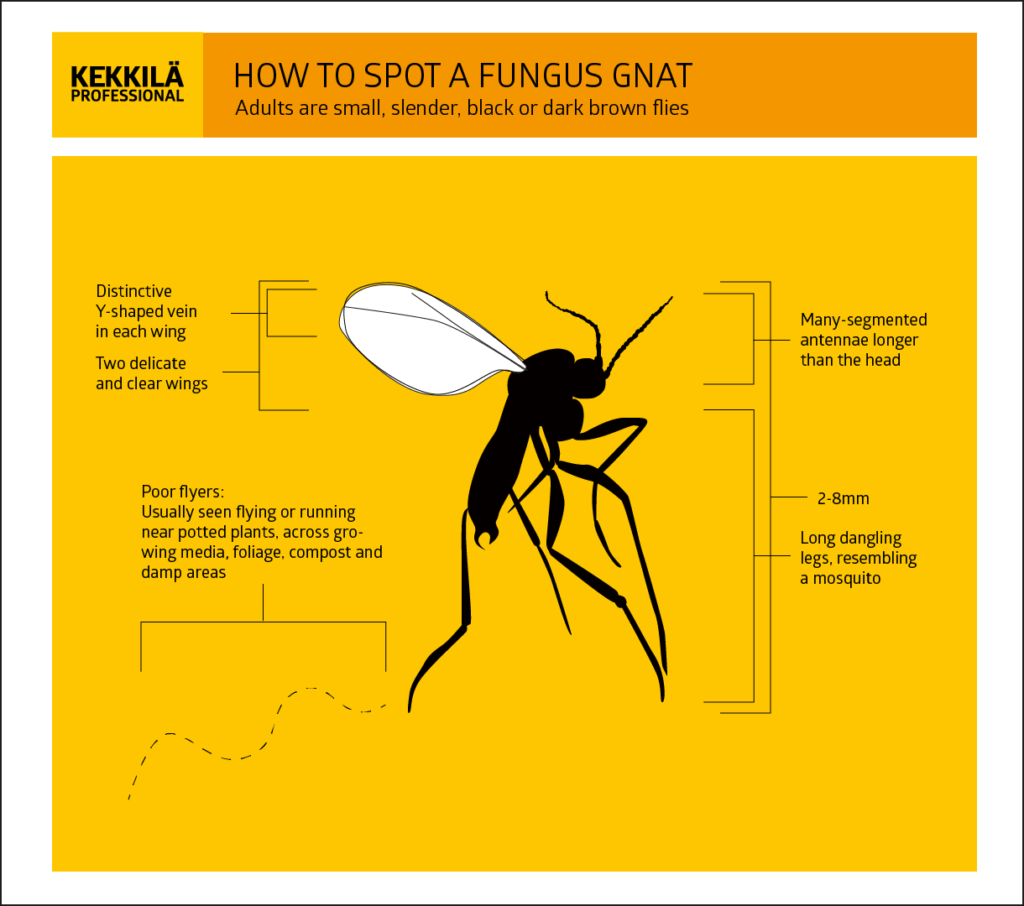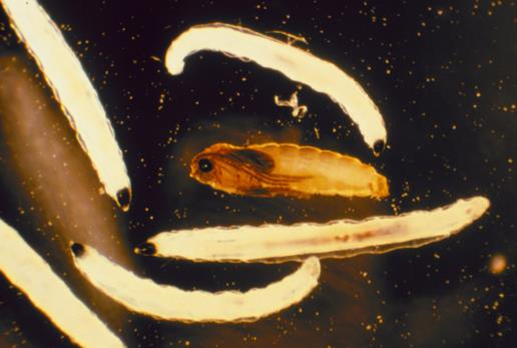The control of fungus gnats in your greenhouse
You have probably seen them before, fluttering through your greenhouse: fungus gnats or sciarid flies. These little mosquito-like flies are a common sight in damp areas. But what do these little insects do exactly? And can they be dangerous to your crops? We will tell you all about them in this article.
What exactly are fungus gnats?
The most common species of fungus gnats that love to hang around in greenhouses are the Bradysia Coprophilia and the Bradysia Impatiens. They are commonly called fungus gnats as their life cycle is closely connected with fungal mycelia. This type of fungus is commonly grows near the surface of pot-grown plants. The little flies prefer damp conditions and are especially common in greenhouses during propagation and plug production. In other words, fungal gnats prefer to live near your developing plants that are still working on establishing strong root systems. Read on to learn about possible damage and the control of fungus gnats.
They develop through four different stages: egg(4-6 days), larva(7-10 days), pupa(5- days) and adult gnat(7-10 days). Females can lay 100-200 tiny eggs each, and they grow up real fast. Within a month the life cycle of the fungus gnat is completed.
The image below helps you recognize adult fungus gnats in your greenhouse.

In general, fungus gnats are not very host specific, but they mainly plague pot plants like Saintpaulia, poinsettia, kalanchoë, carnations, geraniums and cyclamen. We advice to inspect your crops systematically to identify the plants and parts of your greenhouse with pest problems. Once you spot fungus gnats make sure to keep good records and monitor adults by placing yellow sticky cards horizontally on the substrate surface (or other flat surfaces). If you’d like to study laral populations you can place a slice of potato on the substrate surface. Remove the potato after 48 hours and inspect the bottom surface to see if there are any larvae present.
What damage can fungus gnats cause in a greenhouse?
So, you probably wonder if fungal gnats can actually cause any problems. Well, yes, unfortunately they, or rather their little larvae can harm your crops. As we have covered above, fugnal gnats love to live near plants that have not yet had the chance to develop well-established root systems and reproduce plenty of little ones in a short period of time.
Fungus Gnat Larvae
And that’s where problems can start. While the adult gnats usually don’t cause any direct damage to plants, the larvae can. Fungal gnat larvae primarily feed on decaying organic material, but they may also feed on roots and root hairs. They can also interfere with callus formation, which causes damage to cuttings. Their nibbling can result in loss of plant vigour and yellowing or wilting of the leaves. They affect the further growth of your plants and the damage can increase when their numbers grow.
Other effects of larva feeding on plant roots are:
- Tunnels into the stems of succulents at, and below the growing media surface. This tunneling can cause the stem to collapse.
- Wounds on stems of roots that allow secondary soil-borne pathogens to enter roots, transmitting fungal pathogens such as Pythium, Verticilium and Fusarium.

The image above shows the larvae and a pupa. The larvae have whitish-clear, legless bodies with small, shiny black heads. Their digestive system is often visible through the transparent body.
Fungus Gnat Adults
Although adult fungus gnats don’t feast on your cuttings, their presence isn’t that thrilling either. Ofcourse we consider them as a nuisance in greenhouses and at the homes of end-consumers of ornamental plants as they are flying around like little drunk pilots. In addition they can also transmit fungal pathogens like Botrytis.
So, it’s pretty fair to say you probably don’t want these guys setting up camp at your greenhouse, and you are wondering about the control of fungus gnats.
What can you do about fungus gnats in your greenhouse?
Well, how can we get those little pests out of our cosy greenhouses? As reasoning with them won’t prove very successful, you want to make your greenhouse less attractive to the fungus gnats. That will help you seize control of fungus gnats. Pay attention to the following things and your gnat-situation will improve significantly:
- Remove discarded plant material and old substrate: Fungus gnats are attracted to dead and decaying plant material
- Don’t allow piles of uncovered substrate and debris:
- Maintain a weed-free environment: In addition to removing weeds from pots, you should also eliminate weeds from inside and outside the greenhouse, including areas underneath benches or behind vents.
- Control algae: Fungus Gnats and Shore Flies breed in algae. Control algae in pots in propagation areas and on/under benches and you take away their nursery. Read more about how to control algae in the greenhouse in this article.
- Avoid overwatering plants: They prefer abundant moisture. Remember to clean up standing water and to eliminate any plumbing or irrigation system leaks.
- Don’t use too much organic fertiliser: As said fungus gnats love decaying plant material. Don’t fertilize with excessive amounts of manure, blood meal or similar organic materials.
Biological control of fungus gnats
Luckily, if the tips above aren’t as effective as hoped you can turn to biological control of fungus gnats. Biological control of fungus gnats is among the most successful greenhouse biocontrol programmes, and is very effective especially when combined with the good practices above. So, this is what you can use:
- Nematodes: Beneficial nematodes effectively control fungus gnats, do not injure plants, are safe for workers, and do not promote insecticide resistance. The most effective nematode for controlling fungus gnats is Steinernema Feltiae.
- Bacteria: Bacillus Thuringiensis (Bt) produces crystal proteins that are toxic to fungus gnats. The toxin is effective for up to 48 hours after application.
- Predatory mites: The soil-predatory mite, Hypoaspis Miles, normally inhabits the top layers of the growing medium where it feeds on fungus gnat larvae.
- Rove beetles: A predaceous, but very likable, rove beetle: Dalotia coriaria (known also as Atheta), is also commercially available and easy to release and establish in greenhouses.
- Parasitic wasps: This small wasp called the Synacra Pauper often occurs naturally in greenhouses and parasitizes fungus gnat larvae.
- Predatory hunter flies: The predatory hunter fly, Coenosia Attenuate, occurs naturally in many greenhouses. They catch and consume adult fungus gnats in mid-air. The larvae of these flies also prey on fungus gnat larvae in the substrate.
For effective control it is necessary to control both the adults and the larvae.
Chemical control of fungus gnats
If somehow all else fails it is possible to use chemical control. Fungus gnat adults are easily killed with many insecticides. The gnats are often reduced or eliminated when growers spray against other pests with aerosols or sprays.
For specific treatment against fungus gnats you can spray the surface of the potting soil and plant parts where adults typically hang out. To control the larvae you should use a light soil drenching or coarse spray. Keep in mind that, when you have big families of fungus gnats inhabiting your greenhouse, it is important to treat cuttings at an early stage to avoid damage later on.
Finally pyrethrin or a pyrethroid may provide temporary, fast-acting control.
Need help in your battle against fungus gnats?
If you’ve tried all of the above and still find your greenhouse pestered by these little airborn offenders, please don’t hesitate to reach out to your distributor!

